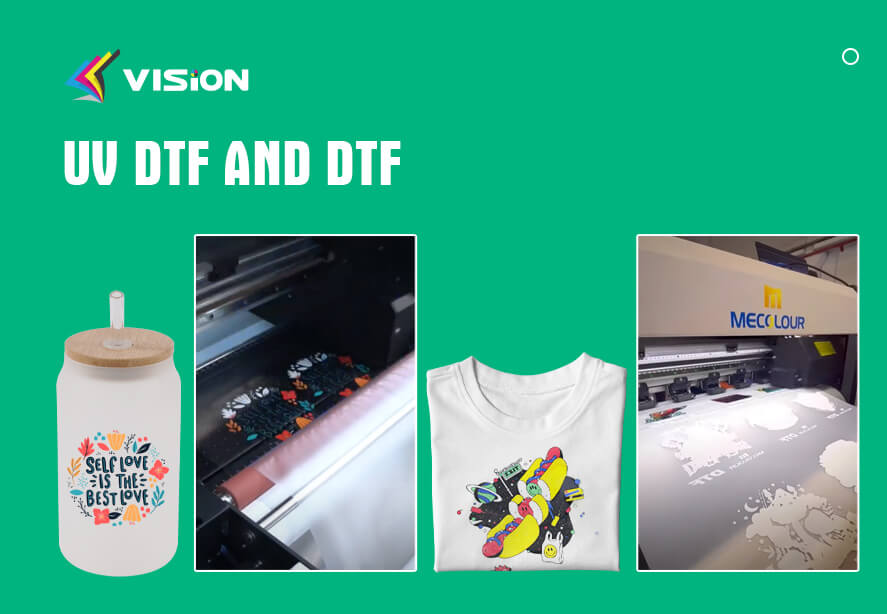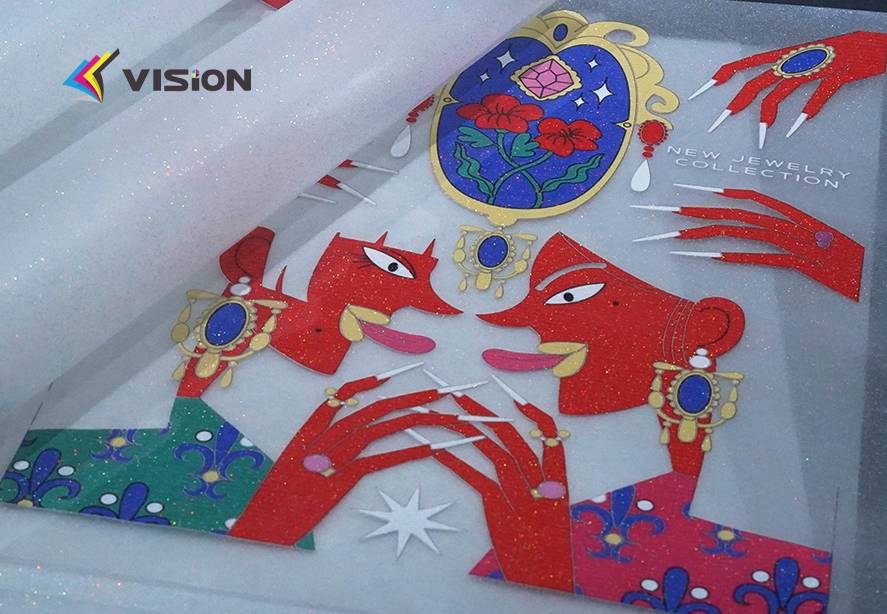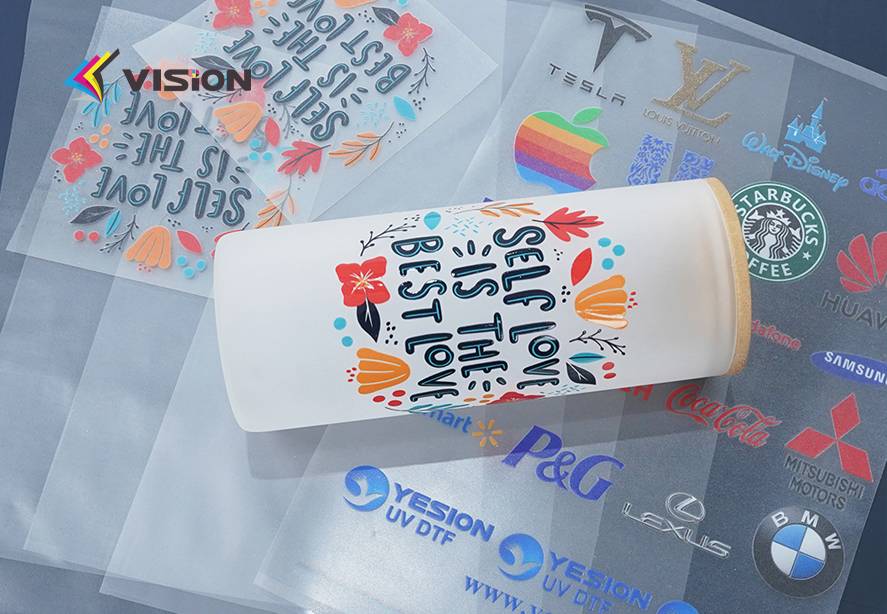What is the difference between UV DTF and DTF?

UV DTF printing is a digital printing technique that uses a UV printer to print UV-curable inks onto a transparent film (called A Film). Then, you need to use a laminator to print the design of A Film to a second PET film (B Film). After that, you simply need to use your fingers to press the laminated PET film on the object for a second, then tear off the film as you would with a sticker. No heat-pressing is required.The A film and B film is call UV DTF Film. This way, UV DTF printing works on many surfaces and can print out vibrant and high-quality images accurately.
How to use uv dtf wrap on tumbler?
Pros and cons of UV DTF Printing
Pros
One of the biggest advantages of UV DTF printing is the high resolution and accuracy of the printed image. The UV-curable ink used in this process is extremely precise, resulting in clear, vivid, life-like images. Additionally, UV-curable inks are capable of producing a variety of colors and designs, allowing for the creation of highly customized and unique prints.
Another advantage of UV DTF printing is that it is very durable. The UV-curable ink used in this process is resistant to fading and washing, meaning the printed image will maintain its quality over time. This makes UV DTF printing ideal for creating long-lasting, high-quality prints for a variety of applications.
Additionally, the method produces prints that are more scratch-resistant than traditional films. This makes it ideal for creating lasting works of art. Finally, this method is relatively environmentally friendly – not only does the printing process itself require less energy and resources, but the quality of the prints means they are less likely to end up in landfill or accumulate as waste elsewhere. All in all, the UV direct to film printing method is arguably one of the best ways to achieve stunning film prints without sacrificing quality or sustainability.
Cons
Requires both UV ink and PET films (A and B Films).
Requires laminating on a separate machine.
Requires delicate handling for UV ink.
Costs more on average compared to DTF printers.
Applications of UV DTF printing
Advertisement materials: including labels and packaging, posters, signage, bottle printing, etc.
Customized products: including leather printing, phone cases, glass, and metal materials.
Home decoration: including printing on tile walls, glass sliding doors, wardrobes, and furniture by using vertical UV printers.
What is DTF?
DTF printing is a technique where designs are printed directly onto the fabric using specialized DTF inks and a heat press. Unlike UV DTF printing, DTF printing does not involve the use of a transfer film.
The process of dtf printing?
Pros and cons of DTF printing
Pros
Soft and breathable prints: DTF prints have a soft feel and excellent breathability, as the ink becomes part of the fabric. This makes DTF printing suitable for creating comfortable and high-quality garments.
Cost-effective: DTF printing is generally more cost-effective compared to other printing methods, as it does not require the use of transfer films or additional equipment.
Versatile and flexible: DTF printing can be used on a wide range of fabrics, including cotton, polyester, and blends. It allows for printing on both light and dark-colored fabrics, offering versatility in design options.
Eco-friendly: DTF printing is considered to be an eco-friendly printing method, as it uses water-based inks that are free from harmful chemicals.
Minimal pretreatment required, compared to Direct to Garment (DTG) printing.
Faster and more efficient than DTG printing.
Excellent light, oxidation, and water resistance on prints.
Cons
Unable to print images of the same color quality and vibrance as UV printing.
Printed pattern is less smooth than that created by UV printing.
Applications of DTF Printing
Apparel and fashion: DTF printing is widely used in the fashion industry for creating custom clothing, including t-shirts, dresses, and activewear. The soft and breathable prints make them comfortable to wear.
Sports and team uniforms: DTF printing is commonly used for printing logos, names, and numbers on sports jerseys and team uniforms. The durability of the prints ensures that they withstand the rigors of athletic activities.
Home textiles: DTF printing can be utilized for printing designs on home textiles, such as bed sheets, curtains, and tablecloths. The soft and vibrant prints add a decorative touch to any living space.
Custom accessories: DTF printing can be applied to various accessories, including bags, hats, and shoes. It allows for customization and personalization of these items, making them unique and eye-catching.
Comparison of DTF, and UV DTF printing
| Printers | DTF printer (e.g. A3 DTF transfer printer) |
UV DTF printer (e.g. A3 UV DTF laminating printer) |
| Printing media | Leather, textile, etc. | Phone case, leather, lithograph, crystal, acrylic,glass, card, CD, U disk, nameplate, etc. |
| Required consumables | Hot melt adhesive powder, DTF ink, and PET film | UV ink, AB film, and glue |
| Printing steps | 1. Use software to prepare the design 2. Print the design on a PET film 3. Powder the PET film 4. Dry the PET film with a heat press 5. Heat-press the PET film onto the material 6. Tear off the PET film |
1. Install films A and B 2. Use software to prepare the design 3. Print and laminate the design on films 4. Transfer the laminated film to the item |
| Ink needed | DTF ink | UV ink |
In conclusion, while both UV DTF and DTF printing methods offer advantages and applications in printing industry, they differ in terms of the printing proces, the characteristics of the prints and applicable substrates. UV DTF printing is known for its vibrant and durable prints, while DTF printing offers soft and breathable prints at a more cost-effective price point.
Both printing methods have their own advantages and disadvantages, so when choosing these two printing methods, you should make a decision based on your own needs. If you want to know more about DTF and UV DTF, please feel free to contact us, VISION, as a professional manufacturer in the printing industry, provide you with more advice for your business.
Related:
The Ultimate Guide to DTF Printing
DTG vs DTF Printing: Which printing Solution is better?





